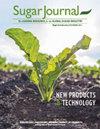使用Putsch Sibomat过滤器的标准白酒过滤
IF 0.3
4区 农林科学
Q4 Agricultural and Biological Sciences
引用次数: 2
摘要
标准的白酒过滤通常使用硅藻土(助滤剂)作为过滤介质。Putsch Sibomat过滤器提供了一种不需要使用助滤剂的替代方案。罗杰斯糖业有限公司(Taber)从2003年春季开始进行了一项测试,目的是测试Sibomat在滤液质量和过滤容量方面的有效性,并确定是否可以消除助滤剂。Taber的标准白酒过滤每生产一吨糖平均消耗2公斤助滤剂,成本接近10万加元。消除或大幅度减少助滤剂的消耗可以产生有吸引力的经济回报。由Putsch提供的Sibomat过滤器测试单元是一个全尺寸组件,只有一个过滤篮。它装有一个55微米的滤网元件,与工厂的主滤网站平行安装。在两次果汁活动和两次甜菜活动中进行测试后,迄今为止的结果表明,合适的甜菜活动操作具有显著的过滤助剂节省,但在两次果汁活动期间的性能都不可接受。在第一次果汁运动期间,Sibomat饲料的助滤剂污染是导致结果不佳的主要原因。不幸的是,在第二次果汁运动中对这个问题的纠正并没有产生可接受的滤液质量改善。浓汁中极细的悬浮物即使更换为33微米的滤网元件也无法去除。在纠正了第一次生产过程中的一些调试问题后,Sibomat处理了高达75%的总汁液流量(平均34立方米/小时),在可接受的循环时间(80至90分钟)内生产出合适质量的滤液。助滤剂用量减少50%以上。在第二次养殖期间,发现了间歇性的性能问题。这一点,加上较高的平均白酒流量,有助于减少助滤剂的节省。虽然在使用Sibomat用于甜菜生产时,有很大的潜力可以节省大量的助滤剂,但目前的数据表明,不能建议完全消除硅藻土滤站。本文章由计算机程序翻译,如有差异,请以英文原文为准。
Standard liquor filtration using a Putsch Sibomat filter
Standard liquor filtration is typically accomplished using diatomaceous earth (filter aid) as the filtering medium. The Putsch Sibomat filter offers an alternative that does not require the use of filter aid. Rogers Sugar Ltd (Taber) initiated a test starting in the spring of 2003 with the objective to test the effectiveness of the Sibomat in terms of filtrate quality and filter capacity and to identify whether elimination of filter aid could be achieved. Standard liquor filtration at Taber consumes on average 2 kilograms of filter aid per tonne of sugar produced, at a campaign cost approaching $100,000 Canadian. Elimination or major reduction in the filter aid consumption can produce an attractive economic payback. The Sibomat filter test unit supplied by Putsch was a full-scale assembly with only one filter basket. Fitted with a 55-micron screen element, it was installed in parallel with the factory's main filter station. Following testing during two juice campaigns and two beet campaigns, results to date indicate suitable beet campaign operation with significant filter aid savings, but unacceptable performance over both juice campaign periods. During the first juice campaign, filter aid contamination of the Sibomat feed contributed significantly to the poor results. Unfortunately, correction of this issue for the second juice campaign did not produce an acceptable improvement in filtrate quality. Very fine suspended matter in the stored thick juice could not be removed even after changing to a 33-micron screen element. After correcting a number of commissioning issues during the first beet campaign, the Sibomat handled up to 75% of the total juice flow (34 m 3 /hour average) producing suitable quality filtrate with acceptable cycle times (80 to 90 minutes). The consumption of filter aid was reduced by more than 50%. During the second beet campaign, intermittent performance issues were identified. This, plus higher average liquor flow, contributed to reduced filter aid savings. Although there is excellent potential for significant filter aid savings when using the Sibomat for beet campaign, current data suggests that total elimination of the diatomaceous earth filtration station cannot be recommended.
求助全文
通过发布文献求助,成功后即可免费获取论文全文。
去求助
来源期刊

International Sugar Journal
工程技术-农艺学
自引率
33.30%
发文量
0
审稿时长
18-36 weeks
期刊介绍:
International Sugar Journal, first published in 1869, is a peer reviewed technical-trade journal focusing on latest developments in sugar technology and sugar industry. The journal embraces scientific and technical advances in agricultural production right through to the production of sugar crystal, as well as economic, trade and policy issues. Main topics include:
• sugarcane and sugar beet production
• front end operations
• cane and beet sugar manufacture
• sugar refining
• economics, trade and legislation and
• biorenewables (cogeneration, biofuels and biobased products)
Related topics, namely analysis, instrumentation, equipment and machinery, food and non-food uses of sugar and alternative sweeteners also form the focus of the journal.
 求助内容:
求助内容: 应助结果提醒方式:
应助结果提醒方式:


